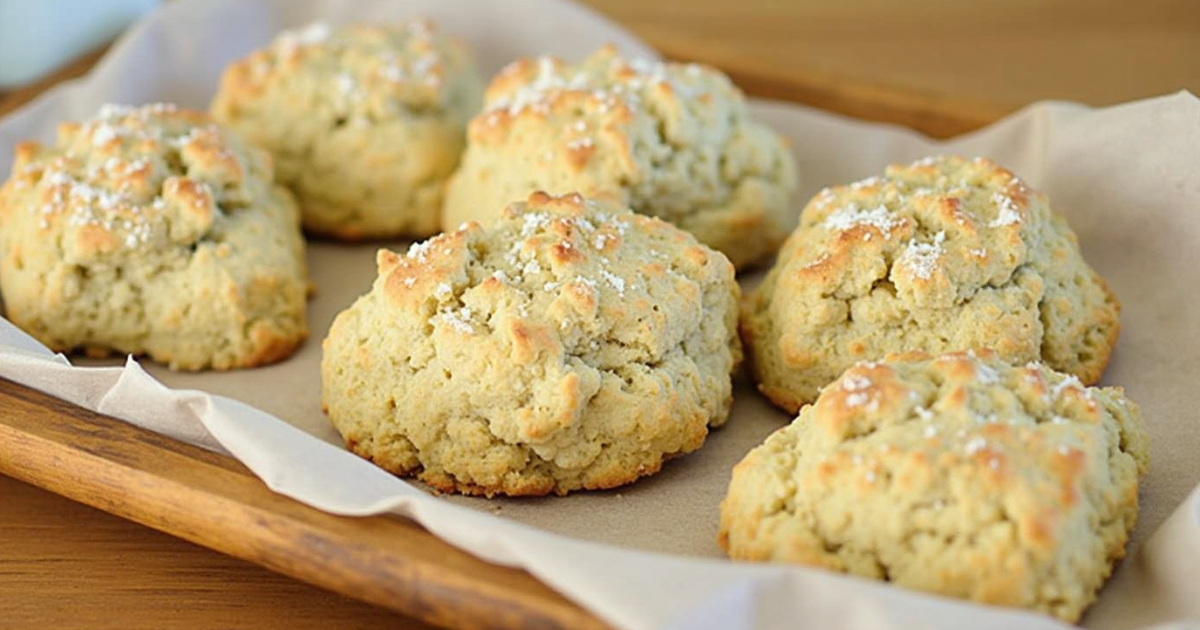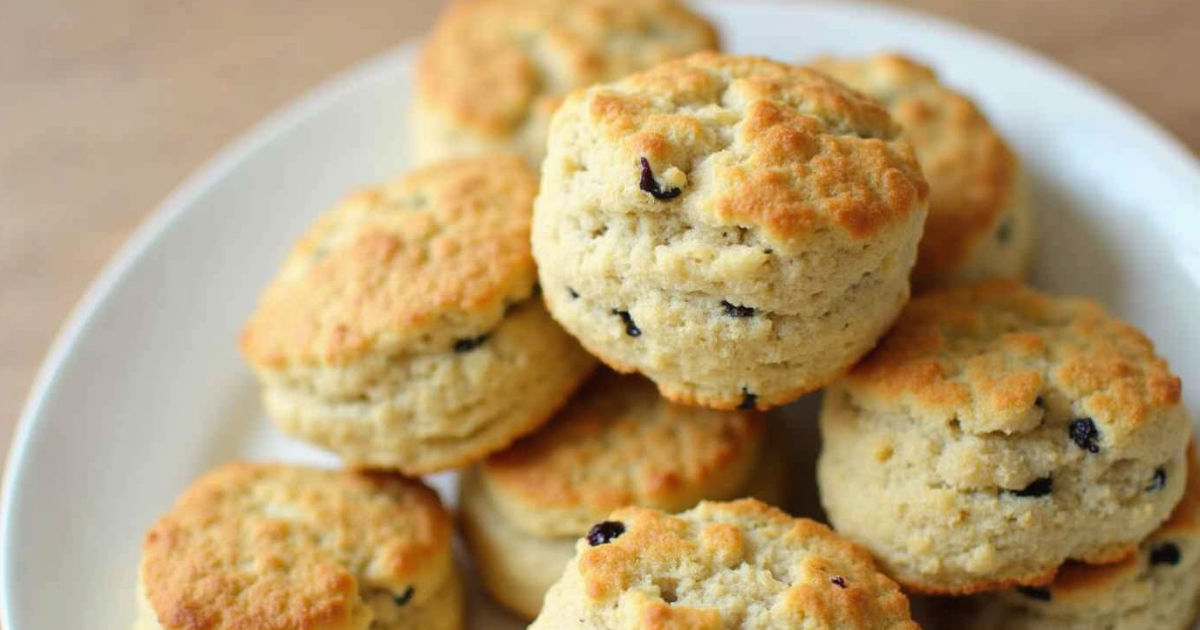
Irish soda bread scones are a delightful twist on the traditional Irish soda bread, offering a soft, moist, and slightly crumbly texture that’s perfect for any occasion. These scones combine the simple ingredients of soda bread—flour, baking soda, salt, and buttermilk—but are shaped into individual portions that make them ideal for serving at breakfast, tea time, or as a snack.
Unlike yeast-based breads, soda bread scones rely on baking soda as the leavening agent, which gives them their signature rise and soft crumb without the need for long proofing times. This makes them incredibly quick and easy to prepare, even for beginner bakers. Plus, they are naturally dairy-rich, thanks to the buttermilk, which adds moisture and a slight tang to the flavor.
The combination of tradition and simplicity in Irish soda bread scones makes them a perfect recipe for anyone looking to bring a little piece of Irish comfort food into their home. Whether you’re making them for a festive occasion like St. Patrick’s Day or as a regular family treat, these scones are sure to become a favorite!
Table of Contents
Key Ingredients for Perfect Soda Bread Scones
To make the perfect Irish soda bread scones, it’s important to use the right ingredients. The key components of this recipe not only contribute to the texture and flavor but also ensure that the scones turn out soft, moist, and perfectly risen. Here are the essential ingredients you’ll need:
1. Buttermilk: The Secret to Softness
Buttermilk is a crucial ingredient in Irish soda bread scones. It reacts with the baking soda to create the rise, resulting in a tender and moist texture. The slight acidity in buttermilk also enhances the flavor and helps the scones stay soft. If you don’t have buttermilk on hand, you can make a quick substitute by mixing one cup of milk with one tablespoon of lemon juice or white vinegar. Before using, let it settle for a few minutes..
2. All-Purpose Flour: The Foundation of Your Scones
For the perfect texture, all-purpose flour is the best choice. It provides the structure needed for the scones without being too dense. You could also try using whole wheat flour for a heartier scone, but the classic recipe calls for all-purpose flour to keep it light and airy. Be sure to measure the flour correctly—sifting it first or spooning it into the measuring cup can help prevent dense scones.
3. Baking Soda: The Leavening Agent
Unlike traditional yeast bread, Irish soda bread scones use baking soda as their leavening agent. Baking soda reacts with the acidity of the buttermilk to create bubbles that help the scones rise. This is what gives the scones their distinctive texture—soft, slightly crumbly on the inside, with a golden-brown crust on the outside. Don’t substitute with baking powder, as it will change the scone’s texture and flavor.
4. Salt: For Flavor Balance
A pinch of salt is essential to balance the richness of the buttermilk and butter in the dough. It helps enhance the overall flavor of the scones without making them too salty. Salt also contributes to the structure of the dough, ensuring the scones hold their shape while baking.
Optional Add-ins: For Extra Flavor
While not necessary, adding extras like currants, raisins, or caraway seeds is a wonderful way to elevate your Irish soda bread scones. Currants and raisins add a touch of sweetness, while caraway seeds bring a subtle, aromatic flavor that complements the richness of the bread. You can also try adding a bit of orange zest for a refreshing twist.
With these simple yet essential ingredients, your Irish soda bread scones will come out soft, moist, and full of flavor every time.
Step-by-Step Guide to Making Moist Irish Soda Bread Scones

Making moist and fluffy Irish soda bread scones is easier than you might think. With a few simple steps, you can have fresh, delicious scones ready to enjoy in no time. Follow this easy guide to ensure your scones turn out perfect every time.
1. Preheat the Oven & Prepare Baking Sheet
Start by preheating your oven to 425°F (220°C). Line a baking sheet with parchment paper or lightly flour it to prevent the scones from sticking. This step ensures that your scones bake evenly and don’t get stuck to the pan during the process.
2. Combine Dry Ingredients
In a large mixing bowl, whisk together 2 cups of all-purpose flour, 1 teaspoon of baking soda, and 1/2 teaspoon of salt. Make sure the dry ingredients are well mixed to ensure even distribution of the baking soda and salt, which are key to the rise and flavor of your scones.
3. Add Butter and Cut It In
Cut 1/4 cup (4 tablespoons) of cold butter into small cubes. Add the butter to the dry ingredients, and use a pastry cutter, fork, or your hands to rub it into the flour mixture until it resembles coarse crumbs. This creates the tender texture of the scones, so be gentle when handling the butter to keep it cold and intact.
4. Stir in the Buttermilk
Make a well in the center of the flour mixture and pour in 3/4 cup of buttermilk. Use a wooden spoon or a spatula to gently stir the mixture until the dough just comes together. Be careful not to overmix—the dough should be shaggy and slightly sticky, which helps keep the scones light and airy. If the dough feels too dry, add a tablespoon of buttermilk at a time until it reaches the right consistency.
5. Gently Shape the Dough
Turn the dough onto a lightly floured surface and gently knead it a few times—just enough to bring it together into a rough ball. Flatten it out into a disc shape that’s about 1 to 1.5 inches thick. You don’t need to knead the dough too much, as overworking it can lead to tough scones. The more delicate you are with the dough, the lighter your scones will be.
6. Cut the Scones
Using a sharp knife or a round biscuit cutter, cut the dough into 8 wedges or circles, depending on your preference. You can also use a cookie cutter for smaller, more uniform scones. If you want a rustic look, you can leave the disc whole and score it with a knife into wedges to make the scones after baking.
7. Bake the Scones
Transfer the scones onto the prepared baking sheet and space them about 1 inch apart. Bake in the preheated oven for about 12-15 minutes, or until they are golden brown on top and sound hollow when tapped on the bottom.Keep an eye on them, as oven temperatures may vary slightly.
8. Cool and Serve
Once baked, remove the scones from the oven and allow them to cool for a few minutes on a wire rack. Serve them warm, ideally with a dollop of butter, jam, or clotted cream. They also make a delicious accompaniment to your afternoon tea or a hearty breakfast.
Tips for Making Soft, Fluffy Scones Every Time
Achieving soft, fluffy Irish soda bread scones requires a few essential tips to ensure that the dough remains light and the texture stays tender. Here are some helpful tips to make sure your scones come out perfectly every time:
1. Use Cold Butter
For the softest, fluffiest scones, it’s essential to use cold butter. The butter needs to remain in small, solid pieces as it bakes, creating air pockets within the dough. This is what gives your scones their light and tender texture. If the butter melts into the dough before baking, your scones may turn out dense instead of airy. For best results, cut the butter into cubes and keep it chilled until ready to use.
2. Handle the Dough Gently
Overworking the dough can result in dense, tough scones. Mix and knead the dough just enough to bring it together. It’s okay if the dough is a little shaggy and uneven. The scones will be lighter if you work with the dough less. Aim to keep the dough as minimal as possible and avoid excessive stirring or kneading.
3. Don’t Overmix
When you add the buttermilk to the flour mixture, mix until just combined. It’s important to avoid overmixing the dough, as this can develop gluten, which will make your scones chewy rather than light. Stir just enough to bring the ingredients together, then stop.
4. Add More Buttermilk If Necessary
If the dough feels too dry or crumbly, you can add a little more buttermilk, one tablespoon at a time. The dough should be sticky but not overly wet. Adding a little extra buttermilk helps keep the scones moist, which is key for softness.
5. Keep the Oven Hot
Make sure your oven is preheated to 425°F (220°C) before baking. A hot oven is essential for creating the initial rise in the scones. It’s the burst of heat when they first go into the oven that helps them puff up and become light and fluffy. Ensure you don’t open the oven door too early, as this can cause the scones to collapse.
6. Use Fresh Baking Soda
Baking soda is a key leavening agent in soda bread scones. If your baking soda is old or expired, it may not react as well with the buttermilk, leading to flat scones. Use fresh baking soda to ensure the dough rises properly and the scones stay light and airy.
7. Don’t Overbake
It’s important to keep an eye on your scones as they bake. Overbaking will lead to dry scones, while underbaking means they might not cook through. Check for doneness by tapping the bottom of the scones; they should sound hollow. Bake them until the tops are golden brown, 12 to 15 minutes. Once baked, let them cool slightly before serving to lock in moisture.
8. Serve Immediately or Store Correctly
Scones are best served fresh out of the oven, but if you have leftovers, store them in an airtight container to keep them soft. Reheat them briefly in the oven or microwave before serving to bring back their warmth and fluffiness.
By following these tips, you’ll be able to make soft, fluffy Irish soda bread scones that are perfect every time. Enjoy the wonderful texture and rich flavor of these traditional treats!

Serving and Enjoying Your Irish Soda Bread Scones
Irish soda bread scones are not only delicious but also incredibly versatile. Whether you’re enjoying them for breakfast, at afternoon tea, or as a comforting snack, there are many ways to serve these delightful treats. Here are some ideas to elevate your scone experience:
1. Classic Butter and Jam
The simplest and most traditional way to enjoy your Irish soda bread scones is with a generous spread of butter and your favorite jam. The richness of the butter complements the soft, crumbly texture of the scones, while the sweetness of the jam adds a perfect balance. You can choose any jam you like, but raspberry, strawberry, or apricot are classic choices.
2. With Clotted Cream for an Extra Indulgence
For a more indulgent treat, serve your scones with clotted cream. This thick, creamy topping is especially popular in the UK and Ireland and pairs beautifully with the light, flaky scones. For the full experience, serve your scones as part of an afternoon tea spread with clotted cream, butter, and jam.
3. Pairing with a Hot Beverage
Irish soda bread scones are a perfect companion for your favorite hot beverages. Tea, especially black or herbal varieties like chamomile or Earl Grey, is a classic pairing. For a heartier pairing, a cup of coffee or a latte can complement the rich flavor of the scones. You could also serve them alongside a glass of freshly squeezed orange juice for a lighter breakfast option.
4. Serving with Cheeses or Meats for Savory Scones
For those who prefer savory flavors, you can serve your Irish soda bread scones with cheese or meats. Soft cheeses like cream cheese or tangy goat cheese pair wonderfully with the scones’ texture. For a heartier option, try serving them with slices of smoked salmon, ham, or even a savory herb spread. Adding fresh herbs such as rosemary or thyme to the dough can also transform the scones into a savory delight.
5. Perfect for Special Occasions
Irish soda bread scones are perfect for celebrating holidays or special occasions. They’re particularly popular around St. Patrick’s Day, but they can also be served for birthdays, brunches, or family gatherings. Serve them alongside other Irish treats like Irish stew or soda bread, and create a festive spread for your guests.
6. Storing Leftover Scones
If you have leftover scones, store them in an airtight container to keep them fresh. You can keep them at room temperature for a couple of days, or freeze them for longer storage. To reheat, simply warm them in the oven for a few minutes or pop them in the microwave for a quick, soft treat. They’ll taste nearly as fresh as when they were first baked!
Enjoying Every Bite
Whether you like your Irish soda bread scones plain, with a touch of sweetness, or paired with savory toppings, there’s no wrong way to enjoy them. These soft, fluffy scones are a versatile treat that can be adapted to suit any taste and occasion. Serve them fresh and warm, and savor the comfort and deliciousness that comes with each bite!
Conclusion
Irish soda bread scones are a perfect blend of tradition and simplicity, making them a delightful treat for any occasion. With just a few basic ingredients, you can create soft, moist, and flavorful scones that are sure to impress. Whether you enjoy them with a dollop of butter and jam, alongside a cup of tea, or even with savory toppings, these scones are incredibly versatile and easy to make.
The best part is that Irish soda bread scones are quick and simple, requiring no yeast and very little hands-on time, making them an ideal baking project for anyone, from beginners to experienced bakers. Plus, with the tips and techniques shared in this post, you can be confident that your scones will turn out light, fluffy, and absolutely delicious every time.
So, whether you’re celebrating St. Patrick’s Day, hosting a tea party, or simply craving a comforting treat, these Irish soda bread scones are the perfect addition to your kitchen repertoire. Happy baking, and enjoy every bite of your homemade scones!
What’s your favorite way to enjoy Irish soda bread scones? Share your thoughts and tips in the comments below!
For more tasty recipes, visit FullMenuRecipes.com and discover more delicious ideas!
Thanks for reading, and happy baking! 🍞”
